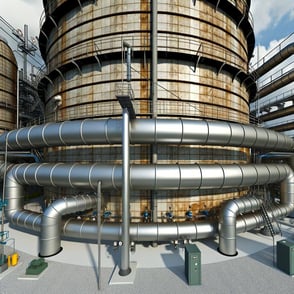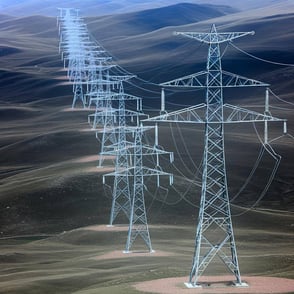Lead-Acid Batteries
What are Lead-Acid Batteries?
Lead-acid batteries are one of the oldest and most widely used types of rechargeable batteries, utilizing chemical storage technologies. They consist of lead dioxide as the positive electrode (cathode), sponge lead as the negative electrode (anode), and a sulfuric acid solution as the electrolyte. Despite being an older technology, lead-acid batteries are still prevalent due to their reliability, robustness, and relatively low cost. They are commonly used in automotive applications, backup power systems, and off-grid energy storage solutions.
How Lead-Acid Batteries Work
Lead-acid batteries consist of several key components: lead dioxide (PbO2) as the positive electrode (cathode), sponge lead (Pb) as the negative electrode (anode), and sulfuric acid (H2SO4) as the electrolyte. The battery operates through a series of chemical reactions that convert chemical energy into electrical energy and vice versa.
The cathode is made of lead dioxide (PbO2), and the anode is made of sponge lead (Pb). These materials are chosen for their ability to participate in the electrochemical reactions necessary for energy storage and release. The electrolyte is a dilute sulfuric acid solution (H2SO4) that facilitates the movement of ions between the anode and cathode during the charging and discharging processes. The separator is a porous material that prevents the direct contact between the anode and cathode while allowing the ionic flow within the electrolyte. It ensures that the battery functions efficiently and safely.
During charging, electrical energy is applied to the battery, causing lead sulfate (PbSO4) on both the anode and cathode to be converted back into lead dioxide, sponge lead, and sulfuric acid. Electrons flow through the external circuit from the anode to the cathode, storing energy in the process. During discharging, the stored chemical energy is converted back into electrical energy. Lead dioxide and sponge lead react with sulfuric acid to form lead sulfate and water, releasing electrons that flow through the external circuit from the cathode to the anode, providing electrical power.
There are several types of lead-acid batteries. Also known as wet cell batteries, flooded lead-acid batteries have liquid electrolyte freely covering the internal plates. They require regular maintenance to ensure proper electrolyte levels and are commonly used in automotive applications and industrial equipment. Sealed lead-acid batteries (SLA) are maintenance-free batteries where the electrolyte is immobilized, either through gel or absorbed glass mat (AGM) technology. SLAs are used in applications where minimal maintenance is desired, such as backup power systems, emergency lighting, and uninterruptible power supplies (UPS). In gel lead-acid batteries, the electrolyte is in a gel form, making them more resistant to leakage and vibration. They are used in deep-cycle applications, such as renewable energy systems, off-grid power storage, and marine applications. Absorbed glass mat (AGM) batteries use a fiberglass mat to absorb the electrolyte, providing improved performance and longer life cycles. They are used in high-performance applications like motorcycles, RVs, and start-stop systems in modern vehicles.
The Impact of Lead-Acid Batteries on the Energy Sector
Lead-acid batteries provide reliable energy storage solutions in regions with limited or unreliable access to electricity. They enhance energy access and security. At the same time, they support the integration of renewable energy sources by storing excess energy and ensuring a stable power supply. The relatively low cost of lead-acid batteries makes them an attractive option for various energy storage applications. Their affordability helps reduce the overall cost of energy storage systems and promotes the adoption of renewable energy technologies.
While lead-acid batteries have environmental impacts due to the use of lead and sulfuric acid, they are highly recyclable. Proper recycling processes can mitigate environmental risks and promote sustainable battery use.
Conclusion
Lead-acid batteries have long been a fundamental component in energy storage solutions due to their reliability, cost-effectiveness, and ability to provide high surge currents. They are essential in automotive applications, uninterruptible power supplies, and renewable energy storage systems. Despite environmental and performance challenges, advancements in recycling and battery technology are helping to mitigate these issues. As a result, lead-acid batteries continue to evolve. Their established presence and ongoing improvements ensure they will remain an important technology for a variety of applications well into the future.
Glossary
- Anode: The negative electrode where oxidation occurs during discharge in a lead-acid battery.
- Cathode: The positive electrode where reduction occurs during discharge in a lead-acid battery.
- Electrolyte: A solution of sulfuric acid that facilitates the movement of ions between the electrodes.
- Separator: A porous material that prevents contact between the anode and cathode while allowing ionic movement.
- Current Collectors: Conductive materials that collect and transfer the electric current produced by the battery.
- Flooded (Wet Cell) Battery: A type of lead-acid battery with a liquid electrolyte that requires regular maintenance.
- Sealed Lead-Acid (VRLA) Battery: A maintenance-free lead-acid battery that uses either absorbed glass mat (AGM) or gel electrolyte technology.
- Sulfation: The accumulation of lead sulfate crystals on the battery plates, which can reduce battery capacity and lifespan.
- Uninterruptible Power Supply (UPS): A system that provides backup power during electrical outages to ensure the continuous operation of critical systems.
- Renewable Energy Storage: The storage of energy generated from renewable sources such as solar and wind power for later use.
.png?width=200&height=80&name=etpa-logo-color%20(1).png)































.png)
.png)
-1.png?width=250&height=100&name=etpa-logo-color%20(1)-1.png)